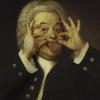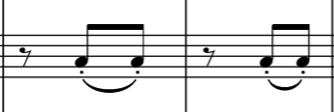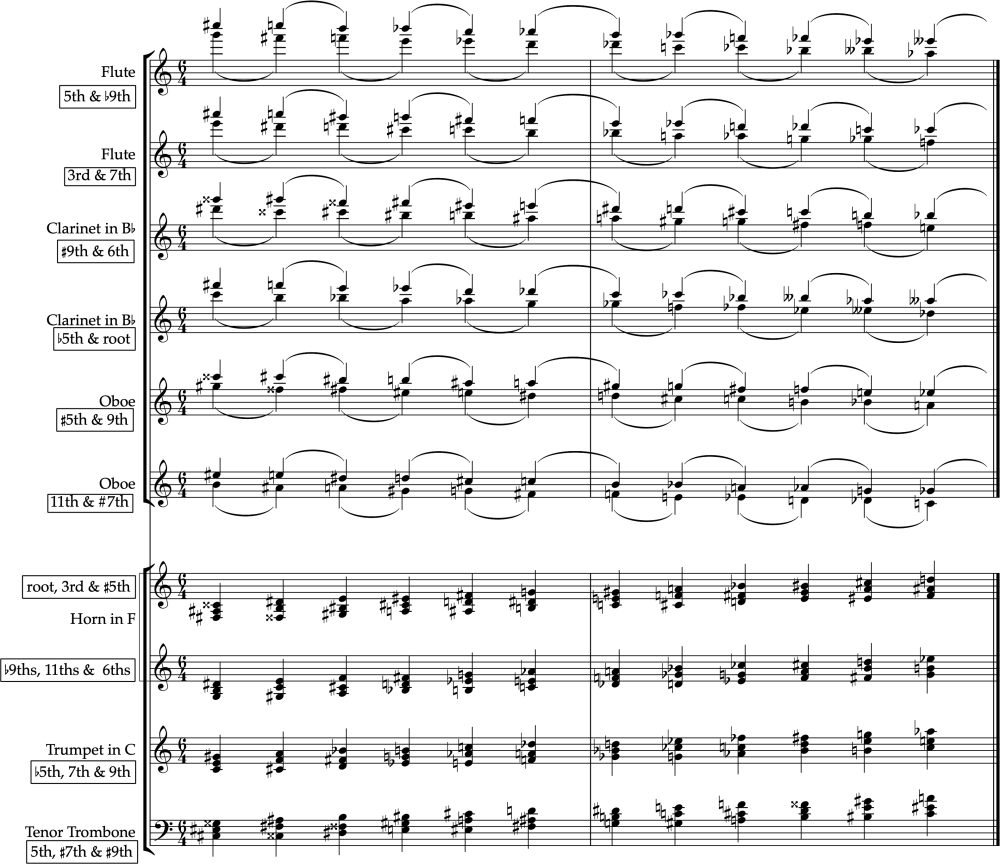All Activity
- Today
-

The Echos of Flame - Work in progress
Henry Ng Tsz Kiu replied to NicholasG's topic in Orchestral and Large Ensemble
I'm wrong LoL, this one is a band score rather than an orchestral one. - Yesterday
-
But you don't only have the viola part follows the piano here, you have the piano playing all 4 parts of the String Quartet which in a way writes like a piano accompaniment to a choir which is common practice there but certainly not a good one here since piano shouldn't be considered an accompaniment in a Piano Quintet. The piano part has its own right to play its own parts, rather only repeating the strings. But ofc if I'm the pianist I would be happy to play it since it would be easy to play with. I 'thing' that having cello plucked would be a nice variation to its part. Remember to hit the like button on the bottom right corner as well so that the reviewer knows that you like their posts. Thx.
-
PeterthePapercomPoser started following The Bitter End
-
I was originally going for a piano quartet (no viola) since I was thinking of having some people perform it, but then one of the violinists stepped up to play viola. Thats why the viola part follows the piano. An extra question: what do you thing about having the cello part plucked for the outer sections
-
Emalyn C. joined the community
-
The Echos of Flame - Work in progress
NicholasG replied to NicholasG's topic in Orchestral and Large Ensemble
ooo maybe -
Henry Ng Tsz Kiu started following The Bitter End
-
EmotionallyChargedMusic started following The Bitter End
-
First piano music composition "The Bitter End" inspired by Akira Yamoka's music An emotionally distressed suicidal woman on the brink of insanity. She begins seeing grotesque monsters manifesting out of her trauma. In shadows deep, her mind unwinds, A fractured heart, a soul confined. Edge of silence, whispers scream, Drowning slow in fractured dreams. Yet through the void, a flicker small, A trembling, fragile, hopeful call. A light so faint, yet softly burns— A chance to rise as darkness turns. The music starts with impending doom and then the piano starts playing and it symbolizes the player begins panicking running escaping from the impending doom as monsters chase.
-
EmotionallyChargedMusic joined the community
-

What Is Your Current Musical Project?
AngelCityOutlaw replied to AngelCityOutlaw's topic in Composers' Headquarters
Nice -
Thx! Yeah I do put a lot of effort in this one I have to admit, im order to speak out things I wanna speak long ago. I do hope to write something more unique as I actually never know what my style is! Thx! The philosophical thinking lingers in my mind at least 10 years I believe when I was reading the Chinese Philosophy Classics, and also guided by my Philosophy Professor who is a student of the Grandmasters of New Confucian School, Tang Chun I and Mou Zhongsan. I may not really know their philosophical thoughts, but always feel myself inspired after reading their works, just like after reading listening to a great piece of music or reading great literature. I just try to write what I feel towards Tao here, plus my own experience. I think it will be very difficult to have it recorded or even performed, so now I don’t have the plan. I know the work can be difficult to play, and it’s too long to be performed, as groups now only prefer much shorter works to perform. Henry
-
Hi @Chemathmusician0510, I agree with @danishali903, the piano shouldn’t just repeat what the strings are playing, but instead have its own part. I wouldn’t go as far as calling the music basic since I think it does display some good chamber music part writing and counterpoint, but I may add more interaction between the instruments and allow other instruments to play the melodic role as well. The piece sounds quite Baroque for me even with those dissonance, because of the drive of the outer sections and the Trio sonata slow movement like middle section. Thx for sharing! Henry
-

The Echos of Flame - Work in progress
Henry Ng Tsz Kiu replied to NicholasG's topic in Orchestral and Large Ensemble
Hi @NicholasG, I like the vibe in it. Maybe one thing is that the clarinet section should be placed above the bassoons? Thx for sharing. Henry -

The End of Things - Suite (WIP)
Henry Ng Tsz Kiu replied to Layne's topic in Orchestral and Large Ensemble
Hi @Layne! I like the beginning augmented chords. Then starts from 0:50 it starts to sound like a film trailer with those chasing rhythm underneath. I feel like the abrupt start of the chorale melody in 1:47 a bit abrupt for me, maybe add a transition between the two passages? The ending does sounds sinister again with the augmented chords and that dissonant ending. Thx for sharing! Henry - Last week
-
InterstellerApex started following The End of Things - Suite (WIP)
-
The End of Things - Suite (WIP)
InterstellerApex replied to Layne's topic in Orchestral and Large Ensemble
I thought it was a great piece. However, a score is definitely helpful, so maybe consider using notation softwares for the actual music before mockup?... (just a thought). I loved the marimbas 🙂 -

New Waltz in C Major for String Quartet or Piano Quintet
danishali903 replied to Chemathmusician0510's topic in Chamber Music
Firstly, I think the audio rendering doesn't do this piece justice. Everything sounds too muddy, and I can barely hear the 2nd violin and viola parts coming through. As to the String Quartet vs Piano Quintet, I don't see the value of having a piano added since it seems to be doubling what's going on in the strings. Leaving this as a string quartet piece would be more logical. Your string writing isn't bad...but it's very "basic". Each instrument/part seems to have a pre-defined range, and the music rarely goes in and out of that range. Maybe throw the melody to the cellist in its higher ranges, or have the viola play something other than this accompaniment role: I also think the transition to the trio section (somewhere around bars 80-82) can be a little more developed, as the trio (bar 83) is VERY different from what came before....just a bit jarring. It might work better, and be a little more interesting, to have that section in a major key. Otherwise, a bit more counterpoint material can help as well. It just sounds very homophonic at the moment. Last comment: The outer sections could use dynamic and phrasing marks. -
Henry Ng Tsz Kiu started following New Waltz in C Major for String Quartet or Piano Quintet
-
Waltz 062725 2 - Full Score.pdf Waltz Qrartet Demo 063025.mp3 This is one I've been working on for a while. I was trying for section something like Tchaikovsky's Valse-Scherzo but lighter for the first section. The mp3 is only string quartet for now. Might have a recording latter, but in the meanwhile. Enjoy!
-

Music Theory Rabbit Hole
Henry Ng Tsz Kiu replied to Chemathmusician0510's topic in Composers' Headquarters
Yeah what's this lol -
What did I get myself into? This descending circle of fifth of dominant chords with extensions has the 3 dim minor 7ths (6 tritones) going downwards and 4 aug chords going up. Result of me trying to voice lead increasingly complex dominant chords.
-
What Is Your Current Musical Project?
Chemathmusician0510 replied to AngelCityOutlaw's topic in Composers' Headquarters
been working on a Choral-Orchestral Theme and variations on a two motives D-F-E-C and G-A-F-E Way to much stuff that I want to compose in the future though -
Hi all! I'm back with a WIP progress piece that I am calling The End of Things - Suite. This has been composed in FL Studio using mostly the Symphony Series Instruments! The ending is unfinished as I plan to go back into a version of the theme from the beginning of the piece. Would love to hear some feedback and what you all think about this piece so far! It's been another foray into experimentation...much like my last piece. This time aiming to try new methods with harmony and building themes...as well as furthering my percussive usage when it's needed. Overall I am loving branching out of my "Compositional Comfort Zone" and trying some new (and often rewarding) things. Parts of the piece have a frantic, almost chase feel to them, others are sinister, and some are more heroic. Overall I wanted each section to feel like part of an End Credits suite...but that all felt like they belonged together in the same project...much like themes in a movie. Hope you all enjoy the listen and looking forward to your feedback! The End Credits WIP - Layne Lee.mp3
-
.thumb.png.8b5b433a341551e913a34392660bc95b.png)
What Is Your Current Musical Project?
PeterthePapercomPoser replied to AngelCityOutlaw's topic in Composers' Headquarters
I am also working on a set of variations and mash-ups on themes not written by me (from a famous videogame). I am using so many themes at once that I am also feeling unmotivated lately to work on it. It seems like one of those never-ending snowballing out of control projects. I hope that I'll finish at least one part of it. I think because of my ginormous orchestral project, the next thing I'll want to write is a piece for 1 monophonic solo instrument accompanied by 1 polyphonic instrument (like the Dreamscapes contest rules). It would be a nice change of pace. And if I manage to write something "dreamy" then it will be all the more interesting. Besides that I was thinking of writing my own variations of more of the themes from the "Bits to Bangers" competition, since I already did the "Harvest Moon" Piano Quintet. I think I majorly prefer working on previously written video game themes, and if not that, then I prefer for my own music to retain a VGM style or media purpose to it somehow. -

What Is Your Current Musical Project?
Henry Ng Tsz Kiu replied to AngelCityOutlaw's topic in Composers' Headquarters
Am working on an Orchestral Variation on @PeterthePapercomPoser's themes. That's going to be my first orchestral piece and also first variation piece. One third of it has been finished but recently just sort oflosing the motivation a bit. I wanna write 2 serial piano pieces, and my life time goal would be to write a Choral Symphony using Chinese Poet's Du Fu's poems. Maybe I feel too tired working on many music these few months. Finishing a Piano Sonata, my dream the String Sextet which I feel so grateful to have finished, a Violin Sonata and a few piano pieces, maybe it's time for me to slow my pace down and absorb more music again. Henry -
Thank you so much, Peter! I always appreciate the feedback. I had not thought of the BTTF theme comparison, but I completely hear it! Thanks for listening! I have been working on a piece (still VERY WIP) that I am planning on sharing here in the forum. Did more exploring of tools, settings, and more and have produced what I would describe as a suite. Haha! Will share soon!
-
Thank you so much! This was a big step out of my comfort zone for percussion. Glad you enjoyed it!
-
Daninsrn joined the community
-
What are you working on at the moment? What do you still want to compose?







